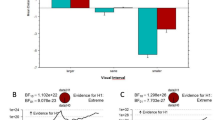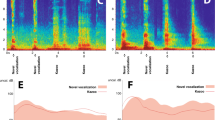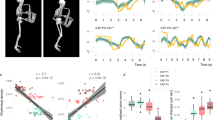Acoustic measurements show how a player can extract a range of timbres from this primitive instrument.
Abstract
The Australian didgeridoo (or yidaki in the Yolngu language of northern Australia) is a simple musical instrument that, at the lips of an experienced player, is capable of a spectacular variety of timbres — considerably greater than those that can be coaxed from orchestral instruments, for example. To understand this phenomenon, we simultaneously measured the sound produced by the didgeridoo and the acoustic impedance of the player's vocal tract. We find that the maxima in the envelope of the sound spectrum are associated with minima in the impedance of the vocal tract, as measured just inside the lips. This acoustic effect is similar to the production of vowel sounds made during human speech or singing1, although the mechanism is different, and leads to the surprising conclusion that experienced players are subconsciously using their glottis to accentuate the instrument's tonal variation.
Similar content being viewed by others
Main
The didgeridoo is traditionally made from a small tree trunk whose core has been eaten by termites. It usually plays only one note, with the player's lips vibrating at a frequency near a maximum in the instrument's acoustic impedance2, which is a measure of how difficult it is to produce air vibration at a given frequency. Its musical value comes from the great variety of timbres and rhythms produced by experienced players as they alter their tongue position and mouth geometry.
Characteristic bands of emphasized frequencies, or formants, occur in the output sound and are similar to the higher formants of spoken vowels3. The acoustic mechanism responsible for the strong formant production has hitherto not been well understood because of the complexity of the interactions between the vocal tract, the lips and the instrument. The acoustic properties of the tract are particularly difficult to measure during performance because of the very high sound levels inside the mouth.
In these experiments, a broadband acoustical current was injected into the player's mouth, just inside the lips, using a tube (diameter, 3.7 mm). A probe microphone next to it (diameter, 1.5 mm) measured the pressure. The acoustic impedance was calculated as described4,5.
Figure 1 shows an example of the vocal-tract impedance. The spectrum of the radiated sound was measured immediately after the impedance measurement, with the player maintaining a constant sound but with no injected broadband current, to avoid this appearing as noise background in the sound spectrum. The sound output is reduced for frequencies at which the vocal-tract impedance is sufficiently large, and the acoustic flow through the lips is inhibited. For frequencies at which the vocal-tract impedance is small, flow into the instrument is greater and more sound is produced. Results were similar on other didgeridoos and with other players. (For details, see supplementary information.) A linear regression of the frequencies of formant maxima/minima against impedance minima/maxima has a slope of 0.93, with correlation coefficient of 0.98 (46 measurements from three players; results not shown).
Spectrum of radiated sound (blue) and the magnitude of acoustic impedance of the vocal tract (red) measured just inside the lips of a didgeridoo player during performance. The player performs the ‘high drone’, produced with the tongue close to the hard palate, which generates a characteristic strong formant at 1.8 kHz. Similar measurements with the tongue in the low position revealed no strong impedance maxima and no strong formants. (For sound file and spectra8, see supplementary information.)
These results indicate that strong formants in the sound depend on the presence of strong resonances in the tract, and this in general requires the glottis to be partially closed to enhance reflection and to prevent the resonant high-frequency components being absorbed in the resistive impedance of the lungs. We conclude that a major difference between a novice and an experienced player is a learned, but usually subconscious, ability to reduce the glottal opening (a similar difference has been proposed for brass-instrument players6). The effect of tongue position on the pitch and timbre of orchestral lip-valve instruments is much more modest because of their relatively narrow bore, but is still musically significant7. An understanding of tract–lip–bore interactions in the didgeridoo, where the effects are pronounced, is likely to lead to an improved understanding of these more subtle effects in orchestral instruments.
References
Sundberg, J. The Science of the Singing Voice (Northern Illinois Univ., De Kalb, 1987).
Fletcher, N. H. & Rossing, T. D. The Physics of Musical Instruments 2nd edn (Springer, New York, 1998).
Fletcher, N. H. Austr. Aboriginal Stud. 1, 28–37 (1983).
Epps, J., Smith, J. R. & Wolfe, J. Meas. Sci. Technol. 8, 1112–1121 (1997).
Smith, J. R., Henrich, N. & Wolfe, J. Proc. Inst. Acoust. 19, 315–320 (1997).
Mukai, S. J. Otolaryngol. Jpn 92, 260–270 (1989).
Wolfe, J., Tarnopolsky, A. Z., Fletcher, N. H., Hollenberg, L. C. L. & Smith, J. Proceedings of the Stockholm Music Acoustics Conference (ed. Bresin, R.) 307–310 (2003).
Music Acoustics http://www.phys.unsw.edu.au/~jw/yidaki.html
Author information
Authors and Affiliations
Ethics declarations
Competing interests
The authors declare no competing financial interests.
Supplementary information
Rights and permissions
About this article
Cite this article
Tarnopolsky, A., Fletcher, N., Hollenberg, L. et al. The vocal tract and the sound of a didgeridoo. Nature 436, 39 (2005). https://doi.org/10.1038/43639a
Published:
Issue Date:
DOI: https://doi.org/10.1038/43639a
This article is cited by
-
Physicists learn secrets of didgeridoo
Nature (2005)
Comments
By submitting a comment you agree to abide by our Terms and Community Guidelines. If you find something abusive or that does not comply with our terms or guidelines please flag it as inappropriate.




